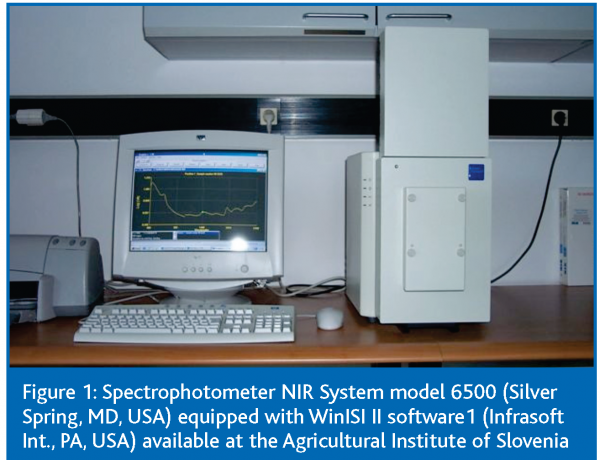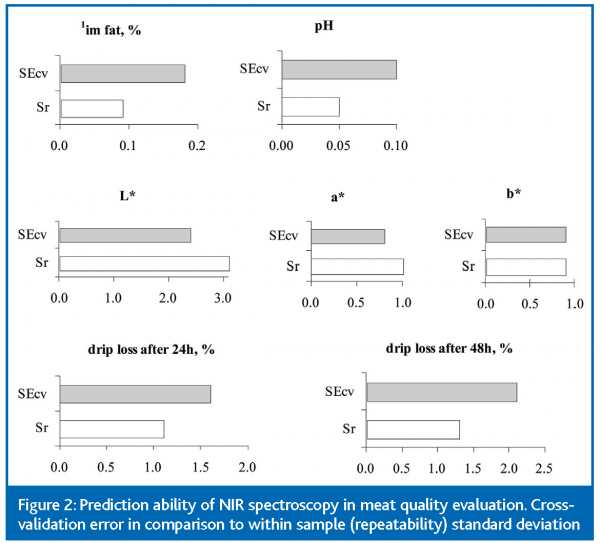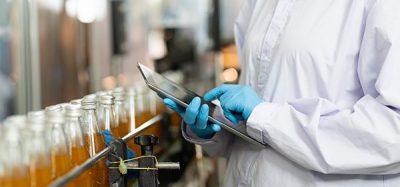Predicting fat and quality of meat
- Like
- Digg
- Del
- Tumblr
- VKontakte
- Buffer
- Love This
- Odnoklassniki
- Meneame
- Blogger
- Amazon
- Yahoo Mail
- Gmail
- AOL
- Newsvine
- HackerNews
- Evernote
- MySpace
- Mail.ru
- Viadeo
- Line
- Comments
- Yummly
- SMS
- Viber
- Telegram
- Subscribe
- Skype
- Facebook Messenger
- Kakao
- LiveJournal
- Yammer
- Edgar
- Fintel
- Mix
- Instapaper
- Copy Link
Posted: 23 May 2006 | Marjeta Candek-Potokar,Agricultural Institute of Slovenia | No comments yet
Use of near infrared (NIR) spectrum as an analytical tool has been established for some time, however it became popular only after the invention of high performance spectrophotometers associated with multivariate data analysis.Today NIR spectroscopy is also widely and successfully used in food analysis. First attempts to use NIR spectroscopy for meat analysis date back more than forty years, but the majority of research work has been carried out in the past decade.
Use of near infrared (NIR) spectrum as an analytical tool has been established for some time, however it became popular only after the invention of high performance spectrophotometers associated with multivariate data analysis.Today NIR spectroscopy is also widely and successfully used in food analysis. First attempts to use NIR spectroscopy for meat analysis date back more than forty years, but the majority of research work has been carried out in the past decade.
Use of near infrared (NIR) spectrum as an analytical tool has been established for some time, however it became popular only after the invention of high performance spectrophotometers associated with multivariate data analysis.Today NIR spectroscopy is also widely and successfully used in food analysis. First attempts to use NIR spectroscopy for meat analysis date back more than forty years, but the majority of research work has been carried out in the past decade.
Several years ago the Agricultural Institute of Slovenia purchased a NIR spectrometer as an analytical tool to replace certain wet chemical analyses. Its potential was soon recognised for the research work on meat quality and professional tasks within animal breeding programmes. Since then two studies have been completed on NIR spectroscopy in relation to meat quality:
- One to deal with the calibration for intramuscular fat prediction
- One using NIR spectroscopy to predict pork technological traits This article will convey our experience and the results achieved.
History
The Agricultural Institute of Slovenia has more than one hundred years of tradition in research and development in agriculture, covering plant and animal production. Meat quality is one of the research topics covered by the Animal production department. However, an aspect of the work also concerns the tasks within the national breeding programmes (carcass and meat quality evaluation), which initiated the idea to profit from NIR spectroscopy. For the purposes of animal breeding programmes, where numerous determinations are needed on a continual basis, it is of great importance to have rapid and affordable methods with acceptable accuracy. Initially, the work on NIR spectroscopy in relation to meat quality began by performing and evaluating calibrations for the determination of intramuscular fat, continued by evaluating the ability of NIR spectroscopy to predict pork technological quality.
Predicting intramuscular fat content
Intramuscular fat content is considered a key factor of meat eating quality. For veal and beef the minimum level of three per cent has been proposed2. For pork, the beneficial impact of intramuscular fat on eating quality seems not to extend to levels above three per cent3,4. For particular products such as dry ham, higher levels of intramuscular fat content are favoured. Due to the beneficial effect of intramuscular fat content on meat eating quality, many selection programmes in cattle and pig included this trait in their breeding goals. Intramuscular fat content is a very variable muscle property related to different factors, among which the most important are species, muscle, breed, sex, weight, age and nutritional level5. It is conventionally determined chemically by extraction, using different organic solvents. Such methods are timeconsuming and associated with high costs, health and environmental risks. The aim of our study was to evaluate whether NIR spectroscopy would be appropriate to replace conventional chemical methods for intramuscular fat determination and be further used in our laboratory in research work and for breeding programme tasks.Within the study some factors that could be important for the accuracy were examined i.e. reference method, sample preparation, spectral range and muscle. In the case of pork, pig carcasses of various breeds, weight and age were included, as well as two muscles; longissimus dorsi with very low intramuscular fat levels and semitendinosus muscle with relatively high levels. In the case of beef, samples were obtained from animals involved in the experiment testing different feeding intensities and from bulls and steers with differing fat levels, but only longissimus dorsi muscle was included. In total, 126 samples were analysed; 92 of pork and 34 of beef.We decided to work with two reference chemical methods for fat determination, methanol-chloroform extraction6 and petrol ether extraction with hydrolysis7. The calibration statistics showed excellent ability of NIR spectroscopy to predict intramuscular fat content. The coefficients of determination obtained by internal cross-validation were between 0.84 and 0.99 and errors between 0.14 % and 0.57 %. Better results were obtained for minced than intact samples, but the results on intact samples are interesting in view of the industrial use. Compared to the repeatability error for chemical determination (0.1-0.2 %) these results show that NIR spectroscopy has an acceptable accuracy to replace laborious chemical procedures for the purposes of large-scale determinations of intramuscular fat. The difference in calibration statistics between two chemical methods used was minor, but it was observed that intramuscular fat content was underestimated (in average approx 10 %) with the Folch method6. Based on our results for specific needs, such as determining intramuscular fat content for purposes of animal breeding programs, models created within muscle seem better. Details regarding the methodology and results are available in recently published material8. It should be noted however that this was the initial study. Before introducing intramuscular fat content determination using NIR spectroscopy into practice, we plan to add samples and test models with an independent set of samples.
Predicting pork technological quality
The most important properties of pig meat quality concern its suitability for various technological processes which, in the case of pork, relate mainly to water holding capacity. Many methods have been used for the determination of water holding capacity e. g. drip loss, filter paper methods, cooking loss and centrifuge force methods9,10,11.Although these methods are rather simple and rapid, they are still not easy to effect under industrial conditions. Thus only the simple measurements indicative of water holding capacity (mostly pH) are used in practice, despite the fact that they can explain only to a limited extent the capacity of meat to retain water11,12. There is an increasing interest in the meat industry for alternative analytical methods to rapidly assess meat quality. In that respect, NIR spectroscopy is considered one of the most promising methods13.At present there are not many studies dealing with the prediction ability of NIR spectroscopy for pork technological quality. Based on the literature review, however, two observations can be made. Firstly, reported results are quite variable and secondly, the ability of NIR spectroscopy to predict fresh meat quality does not seem very persuasive14, 15, 16, 17. Since the quality of the prediction model depends on the range and distribution of property to be measured and the accuracy of the reference results18, we decided to make judgement on the prediction ability of NIRS spectroscopy taking into consideration the precision of reference results. Our study thus consisted of the following:
- Performing the calibrations and cross-validations for fresh meat quality traits (pH, CIE colour parameters L*, a*, b* and drip loss) based on NIR spectroscopy information
- Evaluating the precision of reference results, addressed in terms of being within sample variation (repeatability standard deviation) of replicate measurements
The study was carried out on 296 muscle samples of pig longissimus dorsi, originating from various hybrids of different carcass weight, two abattoirs and five series of slaughter, which permitted a large variation of traits used for calibration. Samples were divided into calibration sets and validation sets. We prepared calibration models for three spectral ranges and two preparations: intact and minced samples. The best calibrations were found for intact meat samples in the 400- 1100 nm spectral range with the coefficients of determination of internal cross-validation between 0.54 and 0.79 (the lowest for L* and the highest for a*), which is moderately high.We performed additional validation on the independent sample set, except with these (the best) models and the crossvalidation errors corroborated well with the errors of prediction on a separate validation set (not shown). Moreover, within sample (repeatability) standard deviation was comparable or slightly lower than the error of cross-validation (Figure 2) and, in our opinion, these results indicate that NIR spectroscopy predicted the studied meat quality parameters as well as possible with regard to the precision of methods (results) to which it was calibrated.A detailed description of the methodological approach, as well as the results, will be available in the original article submitted for publication19.
Conclusion
Our results support NIR spectroscopy as a method of great potential for rapid meat quality evaluation. In particular cases, such as determination of intramuscular fat content for animal breeding purposes, it is undoubtedly very practical and accurate enough to replace chemical methods.As for other meat quality traits, for example water holding capacity, we consider that NIR spectroscopy has the potential but is limited by the methodology related to the reference method. According to the literature, the prediction ability of NIR spectroscopy seems more efficient when assessing meat quality in terms of categorisation, which is the avenue we intend to pursue. There is also a need for additional research regarding industrial use, given that our studies were made with laboratory equipment and may require method adaptation for industry application.
Acknowledgement
The results presented in this article are extracted from two original articles8,19 and were obtained within a project L4- 6376-0401-04/4.02 co-funded by the ministries responsible for the science and agriculture of the Republic of Slovenia.




References
- WinISI II Manual,Version 1.50. Infrasoft International, LLC, Port Matilda, PA, USA (2000).
- H. Eichinger, G. Beck, Possibilities for improving breeding value estimation of meat quality in cattle by using the near-infrared measurement technique,Archiv für Tierzücht 35, 1–2, 41–50 (1992).
- C. Bejerholm, P. Barton-Gade, Effect of intramuscular fat level on eating quality of pig meat, Proc. 32th Europ.Meet. Meat Res.Workers,Ghent, Belgium, 389–391 (1986).
- X. Fernandez, G.Monin,A. Talmant, J.Mourot, B. Lebret, S. Gilbert, J. Sirami, D.Malter, C. Bazin, Influence de la teneur en lipides intramusculaires sur les qualités sensorielles et l’acceptabilité par les consommateurs de la viande de porc et du jambon cuit. synthese des résultats obtenus dans le cadre du projet “agriculture demain”, Journées Rech. Porcine en France 30, 51–59 (1998).
- B.Lebret, L. Lefaucheur, J.Mourot,M. Bonneau, Influence des facteurs d’élevage sur la qualité de la viande de porc, Journées Rech. Porcine en France 28, 137–156 (1996).
- J. Folch,M. Lees, C. Sloane-Stanley,A simple method for the isolation and purification of total lipids from animal tissue, J. Biol. Chem. 226, 497–509 (1957).
- SIST ISO 1443: 2001,Meat and meat products, Determination of total fat content, International organization for standardization (2001).
- M. Prevolnik,M.Candek-Potokar, D.Sv korjanc,Sv . Velikonja-Bolta,M.Sv krlep, T.Znidarsic, and D. Babnik. Predicting intramuscular fat content in pork and beef by near infrared spectroscopy, Journal of Near Infrared Spectroscopy 13, 77-85 (2005).
- K.O. Honikel, The water binding of meat, Fleischwirtschaft 67, 9, 1098-1102 (1987).
- G. R. Trout,Meat Science, Techniques for measuring waterbinding capacity in muscle foods, 23, 235-252 (1988).
- C. P.Allison,M. J. Ritter, and M. E. Doumit, Techniques for quantification of loin muscle water-holding capacity, 3rd Annual Pork Quality Improvement Symposium,Michigan State University;USA, (2002). http://www.meatscience.org/Pubs/pqiarchv/2002/index.html
- E. Huff-Lonergan, T. J. Baas,M.Malek, J. C.M. Dekkers, K. Prusa and M. F. Rothschild, Correlations among selected pork quality traits, J.Anim. Sci. 80, 617–627 (2002).
- G.Monin, Recent methods in predicting quality of whole meat.Meat Science 49, 1, 231–243 (1998).
- G. H. Geesink, F. H. Schreutelkamp, R. Frankhuizen, H.W. Veder,N.M. Faber, R.W. Kraner and M.A. Gerritzen, Prediction of pork quality attributes from near infrared reflectance spectra,Meat Science 65, 661–668 (2003).
- J. Brøndum, L.Munck, P. Henckel,A. Karlsson, E. Tornberg, S.B. Engelsen, Prediction of water-holding capacity and composition of porcine meat by comparative spectroscopy,Meat Science 55, 177–185 (2000).
- B. Leroy, S. Lambotte,O. Dotreppe, H. Lecocq, L. Istasse and A. Clinquart, Prediction of technological and organoleptic properties of beef longissimus thoracis from near-infrared reflectance and transmission spectra,Meat Science 66, 45–54 (2003).
- Y. Liu, B. G. Lion,W. R.Windham, C. E. Realini, T. D. D. Pringle, S. Duckett, Prediction of color, texture, and sensory characteristics of beef steaks by visible and near infrared reflectance spectroscopy,Meat Science 65, 1107-1115 (2003).
- I.Murray and I. Cowe, in Near-infrared spectroscopy in agriculture: Sample preparation, Ed. by C.A. Roberts, J. Workman Jr. and J. B. Reeves III.American Society of Agronomy, Inc., Crop Science Society of America, Inc., Soil Science Society of America Inc.Madison,Wisconsin, USA, p. 75-114 (2004).
- M. Candek-Potokar,M. Prevolnik,M.S krlep,Ability of NIR spectroscopy to predict pork technological traits, submitted for publication.







